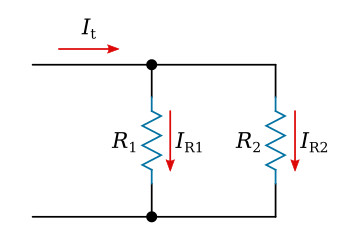Home > Textbooks > Basic Electronics > DC Circuits > Current Dividers >
DC Circuits
Current Dividers
A current divider may be considered basically as some combination of impedances that will cause the output current of a network to be less than the input current. We shall restrict our discussion of current dividers to their simplest forms.
Consider figure below, which shows a line current It, feeding two branches so that It splits into IR1 and IR2. We should like to find a simple relationship between IR2 and It in terms of the branch resistances R1 and R2.

Since R1 and R2 are in parallel, the voltage across them must be the same. Therefore, IR1R1 = IR2R2. We want It and not IR1 in our final expression. Therefore, let us express IR1 in terms of It. Obviously, It = IR1 + IR2. Therefore, IR1 = It - IR2. By substitution, (It - IR2)R1 = IR2R2. Solving for IR2, we obtain

At this point, we want to show what a simple phrase such as "solving for IR2" implies. The following algebraic manipulations were involved
![]()
Therefore
![]()
which as stated above yields

To continue with our problem, it can be shown similarly that

Notice here that, in this type of formula, as compared with that for the voltage divider, the numerator contains the shunt impedance, whose current we are not interested in.






